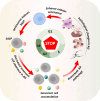Cellular senescence in Alzheimer's disease: from physiology to pathology
- PMID: 39568081
- PMCID: PMC11577763
- DOI: 10.1186/s40035-024-00447-4
Cellular senescence in Alzheimer's disease: from physiology to pathology
Abstract
Alzheimer's disease (AD) is one of the most common neurodegenerative disorders, characterized by the accumulation of Aβ and abnormal tau hyperphosphorylation. Despite substantial efforts in development of drugs targeting Aβ and tau pathologies, effective therapeutic strategies for AD remain elusive. Recent attention has been paid to the significant role of cellular senescence in AD progression. Mounting evidence suggests that interventions targeting cellular senescence hold promise in improving cognitive function and ameliorating hallmark pathologies in AD. This narrative review provides a comprehensive summary and discussion of the physiological roles, characteristics, biomarkers, and commonly employed in vivo and in vitro models of cellular senescence, with a particular focus on various cell types in the brain, including astrocytes, microglia, oligodendrocyte precursor cells, neurons, and endothelial cells. The review further delves into factors influencing cellular senescence in AD and emphasizes the significance of targeting cellular senescence as a promising approach for AD treatment, which includes the utilization of senolytics and senomorphics.
Keywords: Alzheimer’s disease; Cellular senescence; Senolytics; Senomorphics.
© 2024. The Author(s).
Conflict of interest statement
Declarations. Ethics approval and consent to participate: Not applicable. Consent for publication: Not applicable. Competing interests: The authors declare that they have no competing interests.
Figures


References
-
- Hayflick L. The limited in vitro lifetime of human diploid cell strains. Exp Cell Res. 1965;37:614–36. - PubMed
-
- Hayflick L, Moorhead PS. The serial cultivation of human diploid cell strains. Exp Cell Res. 1961;25:585–621. - PubMed
-
- Aunan JR, Watson MM, Hagland HR, Soreide K. Molecular and biological hallmarks of ageing. Br J Surg. 2016;103:e29-46. - PubMed
Publication types
MeSH terms
Grants and funding
LinkOut - more resources
Full Text Sources
Medical

